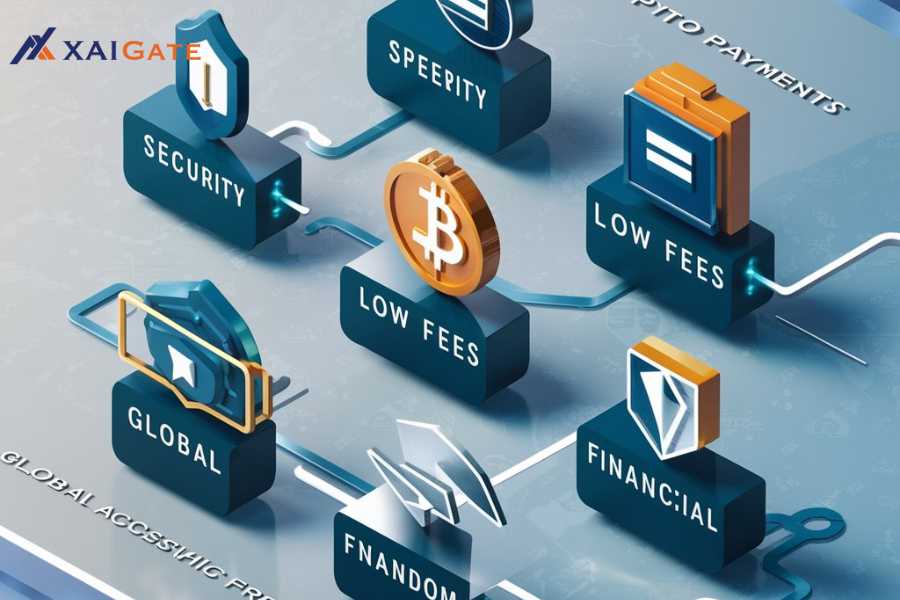“Crypto payments” are payment methods that allow digital currencies such as Bitcoin, Ethereum. And other cryptocurrencies to be used for making transactions. These transactions take place within the framework of a blockchain, which is a decentralized and incorruptible database that guarantees privacy and openness. Before a user makes a payment, it is subjected to verification by many nodes working through consensus protocols. After confirmation has been made, then it will go to the chain hence rendering it immutable and traceable.

Introduction to Crypto Payments
The financial landscape is rapidly being transformed by “crypto payments” that allow for secure, fast and decentralized transactions. These digital payments make use of blockchain technology which makes them more secure and transparent than traditional means. Lower transaction costs and cross-border transfers are some of the reasons why businesses as well as ordinary people are adopting cryptocurrency. With crypto payment usage on the rise, it is important to understand how they work, their benefits and possible problems.

Definition and Significance of Crypto Payments
“Crypto payments” denote the employment of cryptocurrencies such as Bitcoin and Ethereum for transaction purposes. These transactions hold importance as they provide an option that is decentralized, secure, and efficient as compared to standard financial systems thereby reducing the number of intermediaries needed while at the same time lowering transaction fees. In addition, crypto payments facilitate worldwide access by allowing efficient international transfer of funds and financial inclusion for those not served by banks.
Digital Currencies Used
Cryptocurrencies are leading in “crypto payments,” providing secure, decentralized alternatives to established banking systems. Bitcoin, Ethereum, and Ripple are just a few of the cryptocurrencies that enable quicker and sometimes less expensive cross-border transactions. Its widespread uptake is changing our perceptions about money and modes of exchanging it altogether.
How Crypto Payments Work
“Crypto payments” allow users to transact using digital currencies directly between themselves using a blockchain network. The network nodes verify these transactions through cryptography thereby guaranteeing security and transparency. Crypto payments differ from conventional payment systems since they are decentralized. Thus eliminating the need for intermediaries and lowering transaction costs.

Payment Initiation
In “crypto payments”, the initiation of payment is the process of starting a transaction whereby a payer generates a request for payment to a payee through cryptocurrency. Often, this involves creating a digital signature in order to authenticate the transaction and providing a wallet address for transferring the funds. The procedure guarantees secure, open and effective value exchange by avoiding middlemen and cutting down transactional expenses.
Transaction Verification in Crypto Payments
The verification of transactions in “crypto payments” guarantees the reliability and safety of digital transactions. It consists of a network of nodes which authenticate and document transactions on a blockchain, thus averting fraudulence and spending twice. This decentralized system strengthens openness and confidence, rendering crypto payments to be dependable for worldwide transactions.

Blockchain Confirmation
The process of confirming a transaction and putting it on the blockchain is called “Blockchain Confirmation” in the world of “crypto payments” . Each confirmation denotes an additional block after the one that holds the transaction, hence ensuring its safety from being altered or revoked. The more confirmations there are, the more likely it is that they will denote finality since fewer people could have access to them.
Crypto Payments Gateways
‘Crypto payment’ gateways allow businesses to accept and process cryptocurrency transactions. They convert digital assets into local currencies or directly integrate with merchant accounts. These gateways provide security features, real-time transactions while they also manage the volatility and compliance aspects of these currencies.

Role and Functionality of Crypto Payments
“Crypto payments” are meant to enable secure and transparent transactions between two parties directly through the blockchain technology. As a consequence of this system therefore, there is no need for intermediaries which reduces transaction costs and time. Furthermore, it provides a trustworthy and decentralized payment system since every transaction is permanently recorded.
Integration Methods
Integration methods used in “crypto payments” incorporate various techniques to align the digital currencies with already existing financial systems. Among these strategies we may point at API integration which works as a real-time transaction tool. Payment gateways which provide an easy user interface, as well as wallet linking that allows for seamless management of funds. All these approaches are aimed at simplifying the use of cryptocurrencies during daily activities and in business settings.
If you’re looking for a way to make your payment procedures easier and faster, use Plugins, APIs, and Hosted Payment Pages. These three methods work to ease the process of receiving payments in different ways: embedding payments into will help you with coding specifics. Going for hosted payment pages will not only take to a secure page designed specifically for processing your transactions but also offer some type of experience. They sculpt the right balance between ease of incorporation, tailoring operations and their protection requirements.
Advantages of Crypto Payments
The advantages of using cryptocurrencies for payments include: speed, global reach, direct transactions with no intermediaries involved and lower processing costs. To enhance security, these transactions are encrypted and decentralized which makes them less prone to fraud. Crypto payments also provide a way for people to be included in the financial system who otherwise would not have been able to if they had relied on conventional banking standards.

Lower Transaction Fees
Due to efficient blockchain networks and lesser costs incurred by middlemen, smaller transaction charges in cryptocurrency payments are attained. This makes them cheaper when compared with conventional monetary systems. It is the proper management of transactions and development of scalability technologies that make these fees lower.
Faster Transactions
In “crypto payments,” quicker transactions imply the reduction of the time it takes for a transaction to be processed and confirmed on the blockchain. Solutions such as the layer-2 advancements and better consensus algorithms are meant to hasten these procedures. Quicker transactions not only improve user experience but also render cryptocurrencies more functional for everyday consumption.
Increased Security and Privacy
The improved consistency in “crypto payments” is usually attained by utilizing cryptographic tricks and dispersed networks that guard against forgers. Through this mechanism, anonymity is ensured because no personal data will be required for every transaction and thus users will not reveal their identity. Blockchain makes use of these principles, thereby making all transactions secure but still anonymous even to outsiders who might want to monitor them.
Global Accessibility
With Bitcoin you yet can be recommendably utilized by all persons connected to internet without regard as to where they stay. Merely having cryptocurrency will allow you send funds across borders at no extra cost. This therefore enhances proper financial inclusiveness especially among marginalized people as well as those living in offshore regions. Additionally, cryptocurrencies allow better distribution of finances globally because they do not depend on conventional banks’ networks.

Challenges and Considerations
Regulatory ambiguity affecting the legality of transactions as well as their stability is one challenge that must be faced when dealing with “crypto payments”. Security threats like hacking or fraud also endanger all the cash on user accounts. Besides, changes in crypto values may result in fluctuation in the amount of money sent and lost during a transaction.
Price Volatility
The term “crypto payments” denotes a sense of price volatility that is both fast and unpredictable. This change may affect the worth of a transaction and create levels of uncertainty for both buyer and seller. In most cases high volatility in this sector demands timely attempts as well as risk management strategies for their handling.
Regulatory and Compliance Issues
Dealing with complexities of jurisdictions means dealing with diverse and evolving legal frameworks that govern ‘crypto payments’ regulatory and compliance issues. They include anti-money laundering (AML) and know-your-customer (KYC) regulations to prevent illegal actions from happening. In other words, compliance hurdles can hinder the acceptance and functioning of cryptocurrency payment systems that involve an incessant change in regulations.
Technical Integration and Support
In “crypto payments,” Technical Integration and Support requires joining blockchain technology with current financial structures and making it work with diverse approaches. It comprises of creating APIs and instruments for seamless trading activities, as well as offering on-going technical assistance to troubleshoot performance issues. The success of such integrations and support systems is essential in guaranteeing dependability, safety, and contentment among users in the field of cryptocurrency payment systems.
Crypto Payments: Adoption in Various Sectors
Cryptocurrency is being adopted across industries, from finance to entertainment, for transactions, investments, and asset management. Blockchain innovations enable new business models, and sectors like real estate and healthcare use crypto for secure transactions. This growing adoption shows the expanding role of cryptocurrencies in society and commerce.
E-commerce
In online shopping, cryptocurrency acceptance by online merchants provides an alternative payment option for customers, thus making them feel that they are buying securely and in contemporary times. This could mean that tech-savvy people are attracted and that payment can be done at lower rates across borders within a short time provided crypto is used. As cryptocurrency payments gain prominence in various e-commerce sites, businesses expand their market reach internationally and stay true to what is trending in innovation.

Retail
Crypto adoption in retail denotes the acceptance of cryptocurrencies by businesses as means of paying for products and services. Therefore, customers have more payment options, while businesses also attract a tech-savvy clientele during this transition. In addition, by integrating crypto payments, retailers may access new markets and enjoy the advantages of quick, global money transfers.

Service Industries
In the service sector, cryptocurrencies are adopted by organizations as a means of payment for their services such as consulting, legal counsel, or entertainment. By doing so, they make more payment alternatives available for clients and minimize costs and quicken processes thus making the transactions easier. Moreover, it indicates that there is an extensive acknowledgment of those electronic coins as real and pragmatic way to settle purchases.
Future Trends and Developments of Crypto Payments
The future of cryptocurrency payments includes the rise of central bank digital currencies (CBDCs) and the integration of blockchain with existing financial systems. Innovations in scalability and security will drive adoption and expand decentralized finance (DeFi) platforms, transforming transaction methods and financial services.
Growing Acceptance and Adoption
Increases in the number of businesses and consumers accepting and adopting cryptocurrency payments means that more digital currencies are being used for transactions. This trend points toward a wider acceptance of cryptocurrencies as a valid and effective payment method. The more institutions and individuals that embrace cryptocurrency payments, the better they fit into the whole financial atmosphere making them a part of everyday life.
Advancements in Technology and Infrastructure
The growth in technology abilities as well as infrastructure aims at developing ultra-fast and highly scalable blockchain networks; besides better digital wallet options. With these improvements brought about, people are now able to conduct transactions faster and securely while also enjoying good service from their platforms’ interfaces thus attracting even more individuals into using virtual money. The ongoing improvement of this area ensures that cryptocurrency can fit well within different monetary regimes or transactions systems.

Conclusion
In summary, the “Crypto payments” signify a paradigm shift in the finance, facilitating rapid, more secure and borderless transactions. All through furtherance in technology and structure, they will probably increase their adoption as digital currencies enter daily trade. Therefore, it enhances financial inclusion and simplifies international transactions.
To stay ahead in this evolving financial landscape, visit Ethereum Payment Gateway and discover how crypto payments can transform your business. Explore cutting-edge solutions for secure and efficient digital transactions today.
XAIGATE is a secure and user-friendly crypto payment gateway that allows businesses to accept cryptocurrency payments from customers around the world. With best crypto payment gateway for woocommerce, businesses can easily integrate cryptocurrency payments into their existing websites or online stores.









How do crypto payments work, and what are the key benefits of using them for businesses and customers?
Crypto payments work by enabling businesses and customers to exchange digital currencies through blockchain technology, without the need for traditional financial intermediaries like banks. Here’s how they work and the key benefits:
How Crypto Payments Work:
Transaction Initiation: The customer selects a cryptocurrency as their payment method at checkout on the business’s website or platform.
Payment Request: The business generates a unique wallet address or QR code for the customer to send the payment to.
Payment Confirmation: The customer sends the desired amount of cryptocurrency to the provided address. The transaction is then verified and recorded on the blockchain.
Transaction Finalization: Once the transaction is confirmed on the blockchain (which may take a few minutes), the business receives the payment, and the customer is notified of the successful transaction.
Key Benefits of Crypto Payments:
Lower Transaction Fees: Crypto payments often have lower processing fees compared to traditional payment methods like credit cards, which can reduce business costs and increase profit margins.
Faster Payments: Cryptocurrencies offer faster transaction processing, particularly for international payments, which can take hours or even days in traditional banking systems.
Global Reach: Crypto payments enable businesses to accept payments from customers worldwide, bypassing the need for currency conversion or dealing with international banking systems.
Security: Blockchain technology ensures that all transactions are encrypted and transparent, reducing the risk of fraud or chargebacks commonly associated with credit card payments.
Privacy and Control: Crypto transactions are pseudonymous, providing more privacy than traditional payment methods. Customers have full control over their funds, and businesses can maintain more direct financial interactions without relying on third-party financial institutions.
Attracting Crypto Users: By accepting cryptocurrency payments, businesses can appeal to the growing demographic of crypto-savvy customers, offering them an alternative to traditional payment methods.
Decentralization: Since cryptocurrencies are decentralized, businesses are not subject to the restrictions or fees imposed by central banks or financial institutions, giving them greater freedom and flexibility.
By adopting XAIGATE’s crypto payment gateway, businesses can seamlessly integrate these benefits, providing a secure, efficient, and cost-effective payment option for their customers while staying ahead in the evolving digital economy.
How do crypto payments work and how are they processed?
Crypto payments involve transferring cryptocurrency from one wallet to another, validated by blockchain miners or validators. The transaction is processed through a decentralized network and confirmed once added to the blockchain.
Want to integrate crypto payments into your business? XAIGATE offers seamless solutions for secure and efficient transactions!
How do cryptocurrency payment processors protect user privacy?
Crypto payment processors protect privacy by using pseudonymous wallet addresses, encrypting transaction data, supporting privacy coins, and minimizing personal information collection.
Want to implement privacy-focused crypto payments for your business? XAIGATE provides secure, anonymous solutions tailored to your needs!